
The Alismatales (alismatids) are an order of flowering plants including about 4,500 species. Plants assigned to this order are mostly tropical or aquatic. Some grow in fresh water, some in marine habitats. Perhaps the most important food crop in the order is the corm of the taro plant, Colocasia esculenta.

Aquatic plants are plants that have adapted to living in aquatic environments. They are also referred to as hydrophytes or macrophytes to distinguish them from algae and other microphytes. A macrophyte is a plant that grows in or near water and is either emergent, submergent, or floating. In lakes and rivers macrophytes provide cover for fish, substrate for aquatic invertebrates, produce oxygen, and act as food for some fish and wildlife.
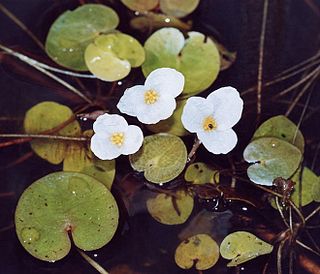
Hydrocharitaceae is a flowering plant family including 16 known genera with a total of ca 135 known species, that including a number of species of aquatic plant, for instance the tape-grasses, the well known Canadian waterweed, and frogbit.
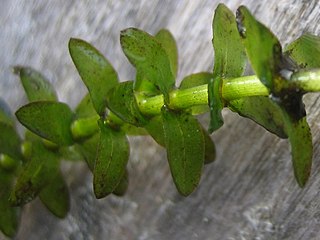
Elodea is a genus of 6 species of aquatic plants often called the waterweeds described as a genus in 1803. Classified in the frog's-bit family (Hydrocharitaceae), Elodea is native to the Americas and is also widely used as aquarium vegetation and laboratory demonstrations of cellular activities. It lives in fresh water. An older name for this genus is Anacharis, which serves as a common name in North America.
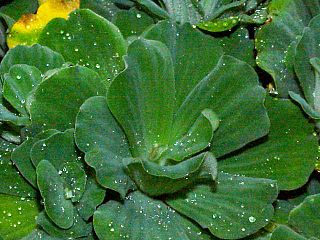
Pistia is a genus of aquatic plants in the arum family, Araceae. It is the sole genus in the tribe Pistieae which reflects its systematic isolation within the family. The single species it comprises, Pistia stratiotes, is often called water cabbage, water lettuce, Nile cabbage, or shellflower. Its native distribution is uncertain but is probably pantropical; it was first discovered from the Nile near Lake Victoria in Africa. It is now present, either naturally or through human introduction, in nearly all tropical and subtropical fresh waterways and is considered an invasive species as well as a mosquito breeding habitat. The genus name is derived from the Greek word πιστός (pistos), meaning "water," and refers to the aquatic nature of the plants. The specific epithet is also derived from a Greek word, στρατιώτης, meaning "soldier," which references the sword-shaped leaves of some plants in the Stratiotes genus.

Pilosella officinarum, known as mouse-ear hawkweed, is a yellow-flowered species of flowering plant in the daisy family Asteraceae, native to Europe and northern Asia. It produces single, lemon-coloured inflorescences. Like most hawkweed species, it is highly variable and is a member of a species complex of several dozens of subspecies and hundreds of varieties and forms. It is an allelopathic plant.

Elodea canadensis is a perennial aquatic plant, or submergent macrophyte, native to most of North America. It has been introduced widely to regions outside its native range and was first recorded from the British Isles in about 1836.
This article gives an overview of the aquatic communities in the British National Vegetation Classification system.
Frogbit or frog's bit is a common name for several plants in the family Hydrocharitaceae and may refer to:
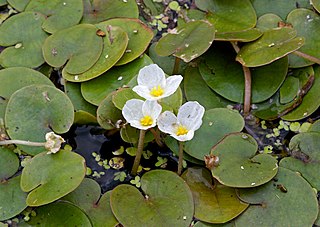
Hydrocharis is a genus of aquatic plants in the family Hydrocharitaceae described as a genus by Carl Linnaeus in 1753. It is widespread across much of Europe and Asia, plus a few scattered locations in Africa. It is also reportedly naturalized in parts of North America.

Pontederia crassipes, commonly known as common water hyacinth is an aquatic plant native to South America, naturalized throughout the world, and often invasive outside its native range. It is the sole species of the subgenus Oshunae within the genus Pontederia. Anecdotally, it is known as the "terror of Bengal" due to its invasive growth tendencies.
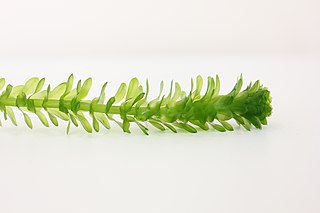
Egeria densa, the large-flowered waterweed or Brazilian waterweed, is a species of Egeria native to warm temperate South America in southeastern Brazil, Argentina, Chile and Uruguay. It is considered a problematic invasive species due to its use in home aquariums and subsequent release into non-native ecosystems.

Cypripedium candidum, known as the small white lady's slipper or white lady's slipper, is a rare orchid of the genus Cypripedium. It is native to eastern North America across the northern United States and southern Canada.

Most organisms involved in water purification originate from the waste, wastewater or water stream itself or arrive as resting spore of some form from the atmosphere. In a very few cases, mostly associated with constructed wetlands, specific organisms are planted to maximise the efficiency of the process.
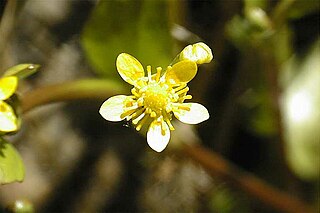
Ranunculus hydrocharoides is a species of buttercup known by the common names frogbit buttercup, or frog's-bit buttercup. It is native to western North America, including the southwestern United States and Mexico. It is also known from Guatemala. It is aquatic or semi-aquatic, growing floating in water or in wet land near water. Typical habitat includes marshes, streams, and lakes. Stems are up to 25 centimeters long, prostrate on the ground when terrestrial, or floating when aquatic. The shiny green leaves have heart-shaped or oval blades up to 3 centimeters long which are borne on petioles which may be 15 centimeters in length. Flowers have 5 to 8 shiny yellow petals a few millimeters long with many stamens and pistils at the center. The fruit is an achene borne in a spherical cluster of 9 or more.

Limnobium laevigatum is a floating aquatic plant, and is a member of the family Hydrocharitaceae. Common names include West Indian spongeplant, South American spongeplant and Amazon or smooth frogbit. This plant was introduced to North American waterways through use in aquariums and aquascapes.

Ottelia is a genus of an aquatic plant family Hydrocharitaceae described as a genus in 1805. The genus is native to tropical and subtropical regions of Africa, Asia, South America, and Australia.

Limnobium, common names spongeplant and American frogbit, is a group of aquatic plants in the Hydrocharitaceae described as a genus in 1814. It is widespread in freshwater environments in Latin America, the West Indies, and the United States.
Located in the Scandinavian Peninsula, Sweden is mountainous and dominated by lakes and forests. Its habitats include mountain heath, montane forests, tundra, taiga, beech forests, rivers, lakes, bogs, brackish and marine coasts and cultivated land. The climate of Sweden is mild for a country at this latitude, largely owing to the significant maritime influence.


















